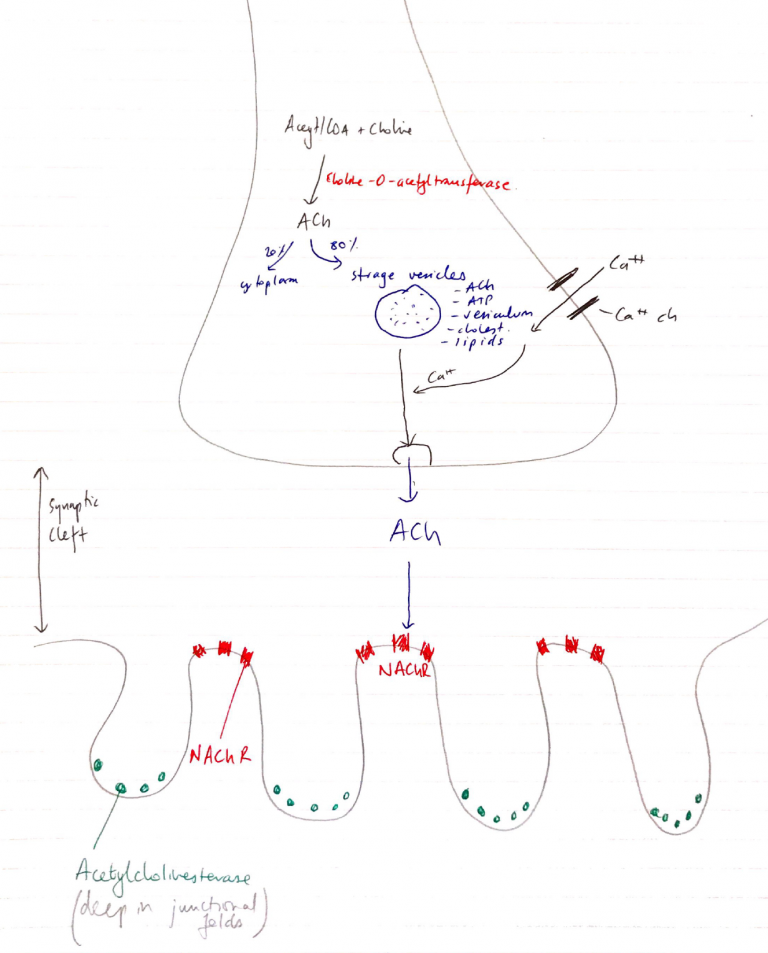L1ii / 25A14 / 19A17: Explain the physiology of neuromuscular transmission
25A14: Exam Report
Describe the structure of the neuromuscular junction (NMJ), including the location of receptors and enzymes (a diagram may assist in your answer but is not required to achieve full marks) (30% of marks).
Explain the events that occur at the NMJ that lead to the onset and offset of a muscle/motor end plate action potential (a description of excitation/contraction coupling is NOT required) (70% of marks).
76% of candidates passed this question.
- Diagrams were useful for many candidates, however others chose to provide a detailed description and also scored well. High scoring answers outlined the structure of the neuromuscular junction (NMJ) including all key functional elements.
- This section required a clear and ordered explanation from the arrival of a presynaptic action potential via motor axon until the restoration of a resting membrane potential in the post-synaptic motor endplate. Many answers ceased their description following the binding of acetylcholine to the nicotinic receptor and degradation by acetylcholinesterase omitting the final steps in returning the motor end plate to its resting state. Common errors arose from confusion between skeletal and cardiac myocyte action potentials.
19A17: Exam Report
Explain the physiology of neuromuscular transmission.
60% of candidates passed this question.
Description of sequential events from axon conduction to detail at the neuromuscular junction was required. Well-constructed answers defined neuromuscular transmission, elucidated the structure of the neuromuscular junction (best done with a detailed diagram), described the central importance of acetylcholine, including synthesis, storage, receptors, and degradation. An ideal answer also described both pre-synaptic (e.g. voltage-gated calcium channels, exocytosis of vesicles) and post-synaptic events (acetylcholine receptors, end plate potentials, and the events that lead to excitation-contraction coupling in skeletal muscle).
L1ii / 25A14 / 19A17: Explain the physiology of neuromuscular transmission
Definition
- NMJ = interface between nervous system & skeletal m.
- NT = ACh
- Skeletal m. innervated by Aα motor neuron
- Aa = large diameter, myelinated, arise from anterior horn SC
- At muscle, Aα axon divides into branches
- Each axon forms a single junction with a muscle fibre
- 1 group muscle fibres innervated by 1 motor n. = MOTOR UNIT
- Each Aα motor n. can innervate 1 – 2000 muscle fibres
- But each muscle fibre only supplied by 1 Aα motor n.
Anatomy
- Aα motor n. approaches muscle → loses myelin & branches into ‘Terminal Buttons’
- Muscle membrane opp Terminal Button is invaginated to form JUNCTIONAL FOLDS
- NAChR is at the top of fold → Anti-cholinesterase enzymes located in valley of folds
- Space b/w Motor End Plate & Terminal Button KA JUNCTIONAL CLEFT
ACh Synthesis & Release
- Nerve cytoplasm: Acetyl CoA + choline → ACh
- 80% stored in vesicles, 20% stored in cytoplasm
- ACh vesicles transported to NMJ
- AP arrives at Terminal Button
- Ca2+ influx at presynaptic terminal
- Vesicle fuses with membrane
- Releases contents into NMJ
- Delayed opening K+ channel then restores membrane potential
NAChR & Events Leading To E-C-C
- 5 units: 2 α, β, γ
- One ACh binds 2 x subunits (+ve cooperativity)
- Channel opens = ↑ permeability to cations (Na, K, Mg)
- Na+ INFLUX (biggest flux), K+ OUTFLOW (down their [ ] gradient)
- Allow depol. of sarcolemma which allows an End Plate Potential (EPP) of -55mV to be reached
- Reaching EPP allows AP to propagate along entire sarcolemma (i.e. muscle AP)
- The AP propagated along sarcolemma → down T tubules
→ Activates DIHYDROPYRIDINE RECEPTORS (voltage gated Ca2+ channels)
→ Ca2+ released → further ↑Ca2+ from adjacent RYANODINE RECEPTORS → mass ↑↑↑Ca2+ intracellularly
Motor Nerve Action Potential
- Motor n. RMP -90mV
- 2 types depolarisation because 2 types ACh release:
1. Spontaneous ACh Release
- Vesicles in Terminal Button randomly fuse with presynaptic membrane
- Release ACh into Synaptic Celft
- Small electrical 1mV charge
- KA Miniature End Plate Potential (MEPP)
2. Mass ACh Release
- Arrival of AP to Terminal Button
- Ca2+ influx presynaptic terminal
- 200 vesicles, containing 1500 ACh each, released into Synaptic Cleft
- Depolarises post-synaptic membrane 50 – 75mV
- Results in End Plate Potential (EPP)
NB: Each nerve releases x 10 amount of ACh needed → margin of safety for normal neuromuscular transmission
- Author: Krisoula Zahariou
